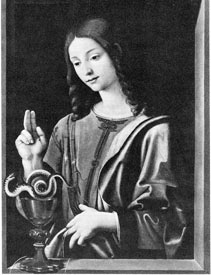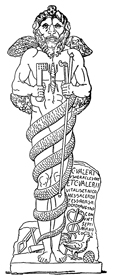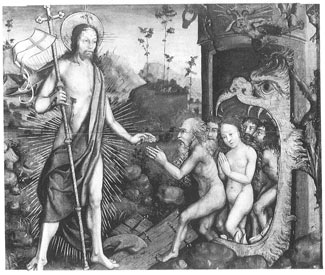
Contents
Overview
Time as a Space-like Dimension
The Physical Fastening of All Thoughts and Actions
Fixed Worldlines of Subjective Experiencing
Accommodation to Everything Being Pre-set
Vertical, Timeless Determinism
Transcending Determinism Requires Two Jumps
Fatedness and Control in Astral Ascent Mysticism

Time can be envisioned as a space-like dimension, forming a block universe that includes personal worldline threads that are frozen and unchanging, and are shaped like snakes. Each snake or thread represents a person’s entire subjective stream of thoughts during their entire life. Analytic philosophy and space-time physics have been brought together to construct a tenseless, static model of time. This perspective is characteristic of altered-state perception.
Salvia divinorum produces a strong sensation of spatial merging and unity. The static, frozen nature of time is perceived as a collection of present moments, with time as a space-like dimension. The mind forcefully and vividly perceives that space is experienced through the medium of present mental representations, rather than being simply present and directly perceived. The feeling of Salvia is strange yet familiar, returning the mind to home-base – the block-universe Origin. All times and locations feel equally nearby and connected to the present.
Metaphors for experiencing embeddedness in the frozen, timeless block-universe include the end of time, imprisonment, and fastening the body to physical objects. Eastern religious myth expresses experiencing the frozen timeless block universe and transcending the idea of autonomous moral agency. Such Eastern myths include the Ground of Being or Tao that flows everywhere including one’s mind, escaping the endless round of moral karma and its unbroken causal chain, and avoiding rebirth into a material, mortal body.
In the dissociative cognitive state, objects and the controlling ego-entity are explicitly perceived as extended across time. Objects and the self are perceptibly distributed along a fixed and pre-set stream of time-slices frozen into position, such that a person appears as a living statue made of a series of separate statues or image-frames in incrementally different poses.
Time is no longer perceived as a flow, but as a frozen expanse and positional relationship of stationary, distinct and separated time-slices. Mental constructs, including personal control-thoughts, are experienced as being permanently laid out along the time axis.
In the dissociative state, all actions anyone has done in the world, good and evil, are experienced as physically attached to one’s own arms, body, and train of thoughts that is frozen into spacetime.
Prometheus is chained looking out from the rock; Theseus and king Pirithous are fused into the banqueting bench in the kingdom ruled by Hades and Persephone; king Pentheus is caught up in the tree looking out; and Osiris is trapped in the coffin by his brother. Conceptually, these mythic figures are all physically connected to the cross Jesus is nailed to, together with his elect: dissociative-state initiates.
King Hades imprisoned Persephone’s would-be suitors (and abductors) by fusing them to a magical bench and binding them to it with snakes while bringing them ‘mixed wine’. It was possible for Heracles to free the divine hero Theseus, but Heracles had to leave king Pirithous behind, fused into the banqueting bench in Hades for eternity, because the whole world shook when Heracles pulled him. This myth describes the dissociative-state sensation of physical embeddedness in the timeless block-universe, followed by abandoning the former pseudo-sovereign model of one’s personal control agency.
A person’s entire subjective life consists of their stream of conscious experience. An experienced life is a worldline frozen and embedded in spacetime in the shape of a snake, or a thread woven and cut by the Fates to a predefined, finite length.
To be ‘bitten by a snake’, as in the allegory of Paul the Apostle after his shipwreck, means to perceive the fatedness of one’s entire stream of thoughts. Like Paul on the road to Damascus, the seer Balaam rode his donkey on a road to curse the Israelites, but ended up blessing them. Balaam had an unavoidable encounter with the angel of death on a narrow vineyard path with no room to turn away to the right or to the left. Balaam was permitted to proceed past the angel only upon acknowledging that he speaks the words God puts in his mouth. The perspective of timeless fatedness reveals that all words that anyone speaks ultimately originate from outside the region of one's personal control.

A house shrine in Pompeii shows a snake of pre-set inevitability reaching the sacrament placed on top of an altar. An initiate’s pre-set worldline of experiencing and thoughts reaches a point where the initiate ingests entheogens. This destined point in the initiate’s worldline was portrayed as a Heimarmene-snake that is drawn by divine Necessity to drink the entheogenic libation of psychoactive wine in the wine-mixing bowl or in a cup of mixed wine, or consume the psychoactive sacrificial cake on the sacrificial altar.

Banqueters on a bench are shown looking at a Heimarmene-snake ending up at their own cup of mixed wine.

John the Evangelist has been shown as blessing a cup of the Eucharistic sacrament shown as a snake.

A maenad, ecstatic follower of the god Dionysus, holds a snake, representing awareness of fatedness and the fixity of one’s entire stream of thoughts.
Sacrifice is predestined and frozen into spacetime, comparable to the labyrinth path leading the sacrificial youths to the Minotaur in the central lair every year, and comparable to a city’s festival procession past sacred landmarks to a sacrifice at an altar. When Perseus shows Medusa’s head covered with Heimarmene-snakes to king Polydectes and his followers at the feast with ‘mixed wine’, the king and the other governors are turned into stone, helplessly frozen.

Kwan Yin masterfully rides the fatedness-serpent through the turbulent sea, with a cup of visionary-plant elixir in hand.
During the visionary-plant initiation, the feeling of being a control-agent moving through time and space is replaced by the sensation and perception of no-free-will. The mind adjusts its mental world-model to fit the transcendent perspective, which includes the experience of frozen-time block-universe determinism.

The Israelites rebelled against the Lord, so the Lord sent snakes which fatally bit them. When the remaining people told Moses they had sinned in speaking against the Lord, the Lord told Moses to put a brass snake on a pole, which the Israelites had to look at to prevent them from dying from these snake-bites. These themes indicate realizing personal non-control with respect to time. A pole represents time, because a pole’s shadow served as a clock. The snake’s shape and rigid composition represent one’s finite-length, pre-set worldline. ‘Fatal snake-bite’ indicates ego death upon seeing all one’s thoughts as timelessly pre-set and given. To be cured of snake-bite and made immune to it is to continue life after ego death, purified of misattribution of the source of one’s thoughts and power of will.
‘The chosen race of God’, ‘the elect’, ‘the immovable race’, and ‘double-predestination’ express the idea that all people are timelessly pre-determined but only some are destined to realize this. ‘The elect’ refers to the set of people who are destined to be experientially initiated into no-free-will, and ‘the lost’ refers to the set of people who are destined to remain under the delusion of autonomous personal control-power.

The wide-eyed Minoan snake goddess ominously wields and controls initiates’ predestined, snake-shaped worldlines.

The initiate’s eventual 2-level system of personal control can be represented as a divine winged snake that rules from above, interconnected with a personal pseudo-autonomous controller snake on the lower level.
In late antiquity, consciousness was centered around the doctrine and mystic-state experience of the pre-setness of future thoughts and occurrences. The central thematic concern of religions in the Hellenistic era was Heimarmene, which means fatedness, Necessity, or timeless cosmic determinism. Modern thought considers some related issues, though only in a single cognitive state. For example, Philosophical Metaphysics investigates the related issues of tenseless time, fatedness, agent movement through space and time, and controller agents.
The future is unchangeable and pre-set because of the static relation of control to the time dimension, and because it is largely an illusion that a person is a continuant agent who exercises power while moving through time.
Modern science introduces clockwork determinism and thereby reduces the person to an automaton; in reaction, Copenhagenist quantum mechanics aims to provide an emancipating alternative to the hidden-variables determinism of Einstein and Bohm. However, modern conceptions of determinism and causality are limited to intellectual speculation based in the ordinary cognitive state, so they habitually tend to envision time as a sequential flow.
Determinism is both a praised goal and a disparaged trap to escape, due to determinism-awareness being the intermediate but not final goal of religious mental transformation. Valentinian Gnosticism affirmed cosmic determinism but also transcended it, and formulated two contrasting schemes of thinking about moral culpability.
Simplified 2-stage initiation themes actually reflect a 3-stage progression that is centered around determinism. Mystic metaphor both endorses and disparages the realization of determinism, because determinism is only an intermediate destination on the path to salvific regeneration. The first demon or stage of egoic delusion to be cast out is the assumption of simple independent self-command and freewill. The second demon to be overcome is the mental model of cosmic determinism or fatedness, a model which is rationally coherent but raises the practical problem of control instability.

Jesus exorcises the ego-demon from a youth supported by his father; these four figures are aspects of the psyche.
Heimarmene or universal fatedness was centrally important in ancient astrological cosmology, and was a major theme in Hellenistic-Roman astral ascent mysticism and religion. Transcending astral fatedness involved ingesting holy food, ambrosial water, and astrological medicine.


Astral ascent mysticism centers around the dangerous gateway or “fatal” boundary crossing – the sphere of the fixed stars – representing the apprehension of Heimarmene and its control of one’s thoughts. The stars wind around the world in a spiral pattern over time; this pattern is depicted by the Heimarmene-snake wrapped around the cosmos, cosmic egg, or Mithraic lion-headed gatekeeper figure.

Saturn, as governor or gatekeeper of the outermost planetary sphere, rides in a serpent-drawn chariot and eats the child or youthful self-concept. The boundary of cosmic determinism is defined by the orbital sphere of Saturn and the sphere of the fixed stars. “Consuming the child” refers to giving up and repudiating one's initial conception of oneself as an autonomous control-agent. Sacrificing one’s “childish”, initial self-conception is the necessary price of passage across the cosmic determinism-boundary, to ascend into the transcendent heavens.
Ancient Jewish writings metaphorically describe mystic-state experiences, including the problem of how to get past various threatening gatekeepers that are encountered during ascent. Pre-modern Christianity held that the body (the lower self) was controlled by Fate, but that the regenerated spirit (the higher, ultra-transcendent part of oneself) was above Fate, residing outside the sphere of the fixed stars.


When harrowing hell and rescuing the elect from limbo, Christ tramples the gates of the underworld prison, which are shown crossed in an X shape. In the pre-modern multi-level cosmology, trampling the gates of the underworld is thematically equivalent to trampling the celestial cross, representing transcending cosmic Heimarmene. Limbo is the experience of how personal control-power is impotent in the face of cosmic determinism and fatedness.

The hidden transcendent thought-source has been depicted as a hand behind a cloud controlling the world-soul, whose spirit transcends material Necessity. The world-soul, in turn, wields a chain that controls creatures, who are subject to Fate.
Up
Copyright © 2007 Michael Hoffman. All rights reserved.